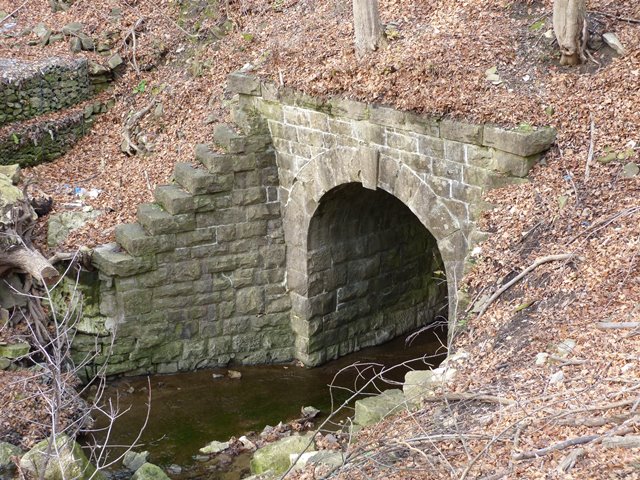We Recommend:
Bach Steel - Experts at historic truss bridge restoration.
BridgeHunter.com Phase 1 is released to the public! - Visit Now
Tiffany Creek Culvert
Tiffany Creek Bridge

Primary Photographer(s): Nathan Holth
Bridge Documented: November 26, 2015
Hamilton (Near Ancaster Heights): Hamilton City, Ontario: Canada
By Builder/Contractor: Unknown
1936
Not Available
Not Available
Not Available
1 Main Span(s)
Not Applicable

View Information About HSR Ratings
Bridge Documentation
This bridge is so small it might be more accurately described as a culvert, but unlike modern culverts, this structure is just as complex in design as a "real" bridge would be. It is a rare and presumably very old 19th Century example of a highway stone arch in Ontario. The northern end of the bridge was widened by adding a concrete box culvert style structure to serve a realignment of King's Highway 2 which once followed this road. According to thekingshighway.ca, this alteration occurred in 1936.
Thanks to Peter Reissner for bringing this bridge to the attention of HistoricBridges.org. Peter is currently trying to research the history of this bridge to see if the stone arch might be so old that it would date to the 1840s and 1850s which would make it among the oldest in Ontario. If you have any knowledge of the history of this bridge, please contact HistoricBridges.org and we can pass this information on as well. Peter provided the following information about the structure and the road it serves:
The road itself has quite a lot of history. It is now Wilson Street, and used to be King's Highway 2, but started as the Iroquois Trail up to end of the 18th century, when it soon became the Hamilton and Ancaster Road, then the Hamilton and Brantford Road, then the Hamilton and Brantford Macadamized Turnpike. I suspect the culvert dates to about the 1840s or 1850s. The road was macadamized starting around 1842. Also, it seems quite obvious to me that the highway 2 surface was much lower when the culvert was built than it is today. There is quite a height of earth above the culvert today. Also, the road at the time the culvert was built would have curved well off the straight course that the current road takes today. Obviously the original trail and road would have followed the best path down the escarpment, not the straightest.
![]()
Photo Galleries and Videos: Tiffany Creek Culvert
Bridge Photo-Documentation
Original / Full Size PhotosA collection of overview and detail photos. This gallery offers photos in the highest available resolution and file size in a touch-friendly popup viewer.
Alternatively, Browse Without Using Viewer
![]()
Bridge Photo-Documentation
Mobile Optimized PhotosA collection of overview and detail photos. This gallery features data-friendly, fast-loading photos in a touch-friendly popup viewer.
Alternatively, Browse Without Using Viewer
![]()
Maps and Links: Tiffany Creek Culvert
Coordinates (Latitude, Longitude):
Search For Additional Bridge Listings:
Additional Maps:
Google Streetview (If Available)
GeoHack (Additional Links and Coordinates)
Apple Maps (Via DuckDuckGo Search)
Apple Maps (Apple devices only)
Android: Open Location In Your Map or GPS App
Flickr Gallery (Find Nearby Photos)
Wikimedia Commons (Find Nearby Photos)
Directions Via Sygic For Android
Directions Via Sygic For iOS and Android Dolphin Browser

